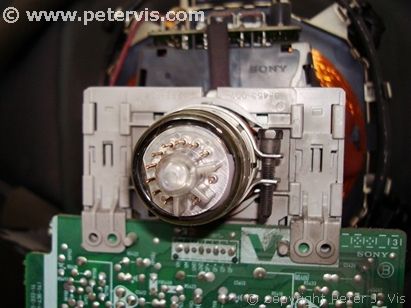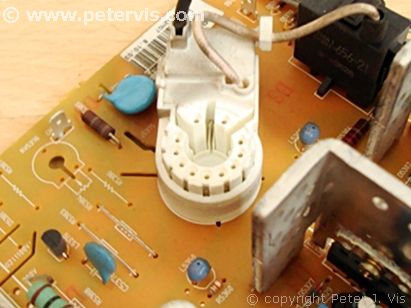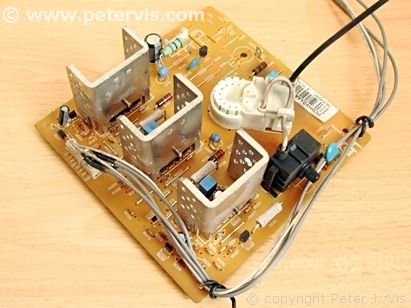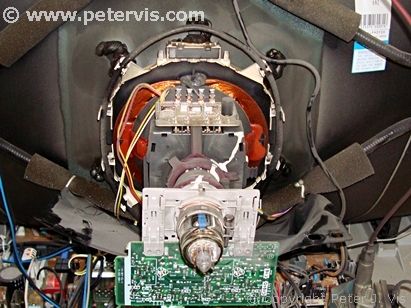How does the electron gun inside a TV work?

An electron gun is a multi-stage assembly of components, which produces and controls a fine stream of electrons using the principle of thermionic emission. At a very basic level, the assembly consists of a heater element, which heats the cathode to produce free electrons. The first stage in the assembly is usually the grid, sometimes called G-1, and its job is to control the beam of electrons passing through it. If it is positive, the electrons pass through, however if it is sufficiently negative it can cut the beam stopping the electrons from passing through. The next stage in the assembly is the focusing anode, which is essentially a positively charged aperture through which the electrons pass. The aperture is usually narrow which focuses the beam to that size. The electrons then pass through another anode stage, which focuses the beam further by passing them through a narrower aperture.
A very important characteristic to understand is that the potential difference across the cathode and final anode determines the kinetic energy of the electrons. Therefore, the electrons are still flowing within a circuit. The negatively charged electrons naturally attract to the positive potential, which is the final anode near the surface of the CRT. The electrons usually travel close to the speed of light, and the assembly produces in the order of billion electrons per second.
Applications
The electron gun is an extremely useful device for the generation of electrons. X-ray machines, field-effect microscopes, and medical imaging rely on streams of electrons. The applications are wide covering medicine, avionics, and spacecraft engines. The most well known application is in the use of cathode ray tube (CRT) displays.
Thermionic Emission
Thermionic emission is the process by which electrons escape the metal in which they are moving. When heating a metal to around 2700 K, the electrons gain enough energy to escape the surface of the metal.
History
The modern electron gun is a descendent of the triode valve, which was an early vacuum tube. Hence, they have similar components in their assembly, and share the same names such as anode, cathode, heater, and grid.
Pinout

An electron gun is a multi-pin device, and in this photograph, you can see the electrical pin connections. Each stage of the gun, consisting of heater element, cathode, grid, and focusing anodes, have electrical connections through these pins.
Socket

An electron gun usually connects to a socket such as this for making the electrical connections with the circuit on the PCB. These sockets are usually made of ceramic material as the heater element in the gun heats up the pins and the glass enclosure as well.
Video Drive PCB

A colour television usually has three electron guns producing three individual beams of electrons. These beams of electrons fall on their respective red, green, or blue phosphor coloured dots on the surface of the screen.
Each electron beam has a grid, which controls its flow and thereby the picture on the surface of the screen. Power transistors usually control the voltage to these grids; hence, there are three transistors on the PCB.
Deflection Coils

An electron gun on its own simply produces a stream of electrons, which falls at the centre of the screen. This usually produces just a bright dot; however, to produce a picture, this beam has to move very fast to cover the whole area of the screen. The deflection coil is the component, which moves the stream to different parts of the screen to build a raster.

The coil produces a rapidly changing magnetic field, which influences the electrons to move. It consists of copper wire wound in a precise shape to fit over the gun. It is usually over the gun assembly to control the position of the beam.
This Article Continues...
Sony Television KV-36FS76UCathode Ray Tube (CRT)
How does the electron gun inside a TV work?
Deflection Coil
Final Anode
Buy a New Television
Television Integrated Circuits
Sony Television Boards & Components
SCART
Television Computer System
LM1876 Overture™ Audio Power Amplifier
Line Output Transformer (LOPT) / Flyback (FBT)
Sony Television PSU
Degaussing Coils
Sony KV-36FS76U Television Speakers
Sony KV-36FS76U Back Cover
A Television Journey
Sony KV-36FS76U Fault Troubleshooting